Lost Vegas
for symphonic band (2011)
I. Viva
II. Mirage
III. Fever
Instrumentation: Piccolo, 4 flutes, 2 oboes, English horn, Eb clarinet, 6 Bb clarinets, bass clarinet, 2 bassoons, contrabassoon; 2 alto saxes, tenor sax, baritone sax; 4 horns, 4 C or Bb trumpets, 3 trombones, 2 euphoniums, 2 tubas; timpani; piano; contrabass; 5 percussion (1 = bongos, congas, 4 temple blocks (very large, large, medium, small), suspended cymbal, crash cymbals, medium triangle, latin cowbell (large), bell tree, tambourine; 2 = claves, suspended cymbal, bass drum (large), 2 latin cowbells (medium and small), large triangle, gong (medium), vibraslap; 3 = glockenspiel, xylophone, suspended cymbal; 4 = vibraphone, chimes; 5 = marimba (4 1/2 octaves), large whip, wind chimes, suspended cymbal)
Publisher: Michael Daugherty Music
Duration: 14:30
World Premiere: February 4, 2011 / Hill Auditorium, Ann Arbor, Michigan / University of Michigan Symphony Band, Michael Haithcock

Program Note:
Lost Vegas (2011) was commissioned by the University of Michigan Symphony Band, Michael Haithcock, conductor, and the University of Miami Wind Ensemble, Gary Green, conductor. Lost Vegas is my musical homage to bygone days in the city of Las Vegas, Nevada. I recall the enormous neon signs punctuating the “Strip,” promoting casinos and hotels ruled by the underworld, and the massive marquees trumpeting performances by pop music legends such as Frank Sinatra and Elvis. Performed without pause, Lost Vegas is divided into three movements.
The first movement, “Viva,” is inspired by the seminal book Learning from Las Vegas (1968–72), by modernist architects Robert Venturi and Denise Scott Brown, who likened the symbolism of the Vegas “Strip” to the Piazza Navona in Rome. The music in “Viva” unfolds as catchy musical riffs are layered and phased in various polytonal guises and orchestrations.
“Mirage,” the second movement, was inspired by my recent drive through the forbidding desert of Death Valley. Located 88 miles west of Las Vegas, Death Valley is one the lowest, driest, and hottest locations in North America. A serpentine oboe solo, later doubled by trumpets with harmon mutes, is surrounded by steamy brass chords and twisting countermelodies played by winds and percussion keyboards. Accompanied by an ominous bass drum, the music in “Mirage” appears and disappears, like an optical illusion one might encounter in the scorching desert, or driving from the pitch-black darkness of Death Valley in the dead of night toward the bright lights of Las Vegas.
The final movement, “Fever,” is a swinging tribute to an earlier epoch, when legendary entertainers such as Elvis, Peggy Lee, Bobby Darin, Stan Kenton, and Frank Sinatra’s “Rat Pack” performed in intimate and swanky showrooms of the Sands, Tropicana, and Flamingo hotels.
Torn down long ago, the original neon signs, casinos and hotels of the Vegas “Strip” have been replaced by impersonal, corporate glass towers. The cozy nightclubs, where the “Rat Pack” once performed edgy material, have been replaced by large arenas, where commercialized family entertainment is now presented. My composition for symphony band is a trip down memory lane to an adventurous and vibrant Vegas that once was and returns, if only for a moment, in Lost Vegas.
–Michael Daugherty
